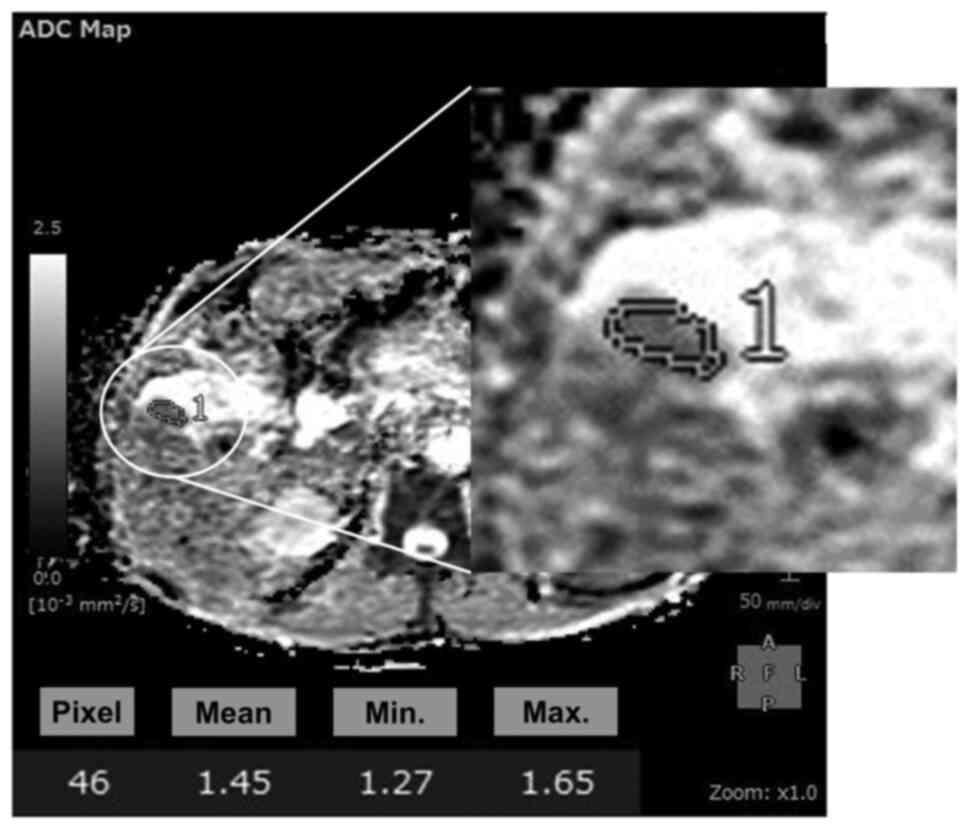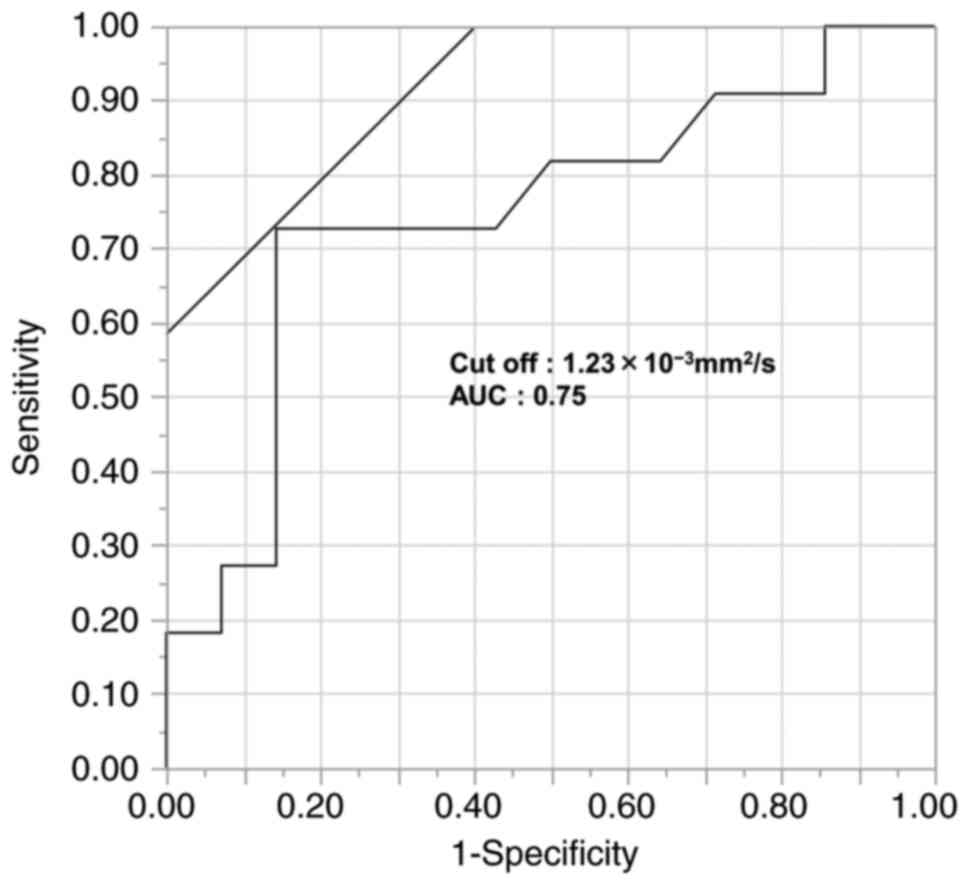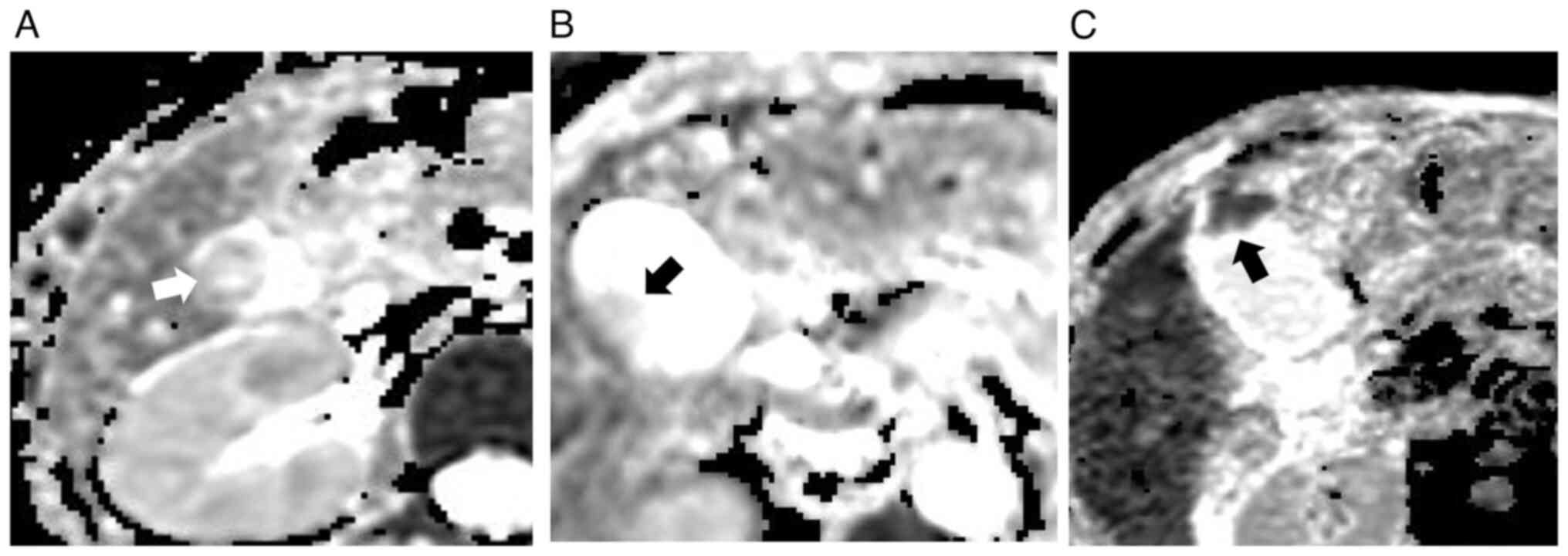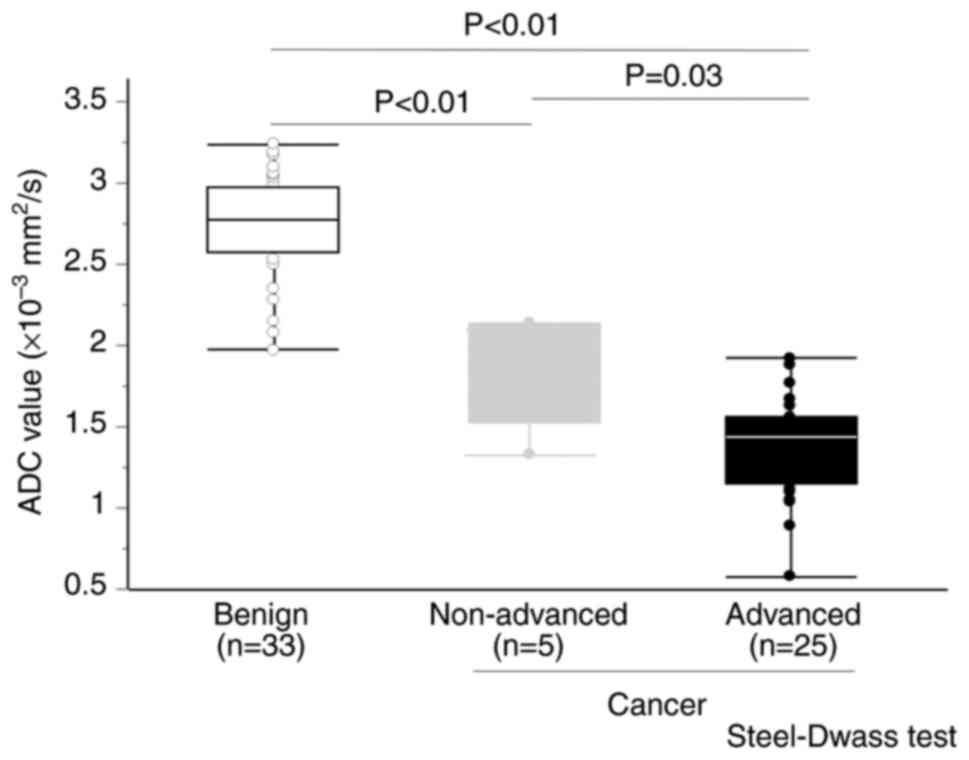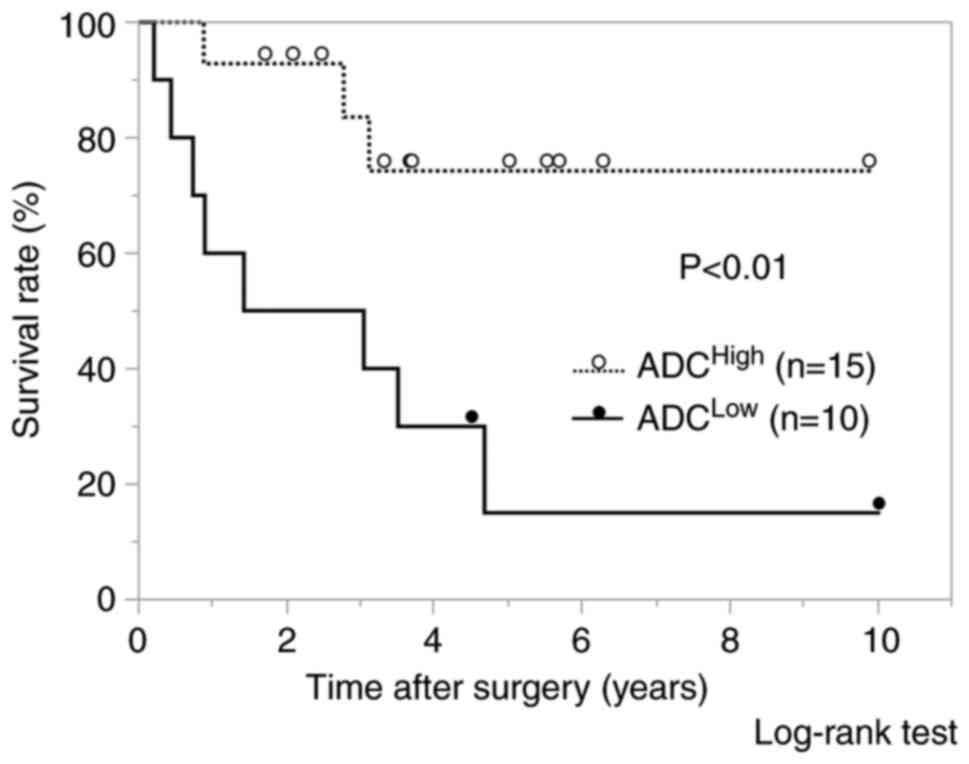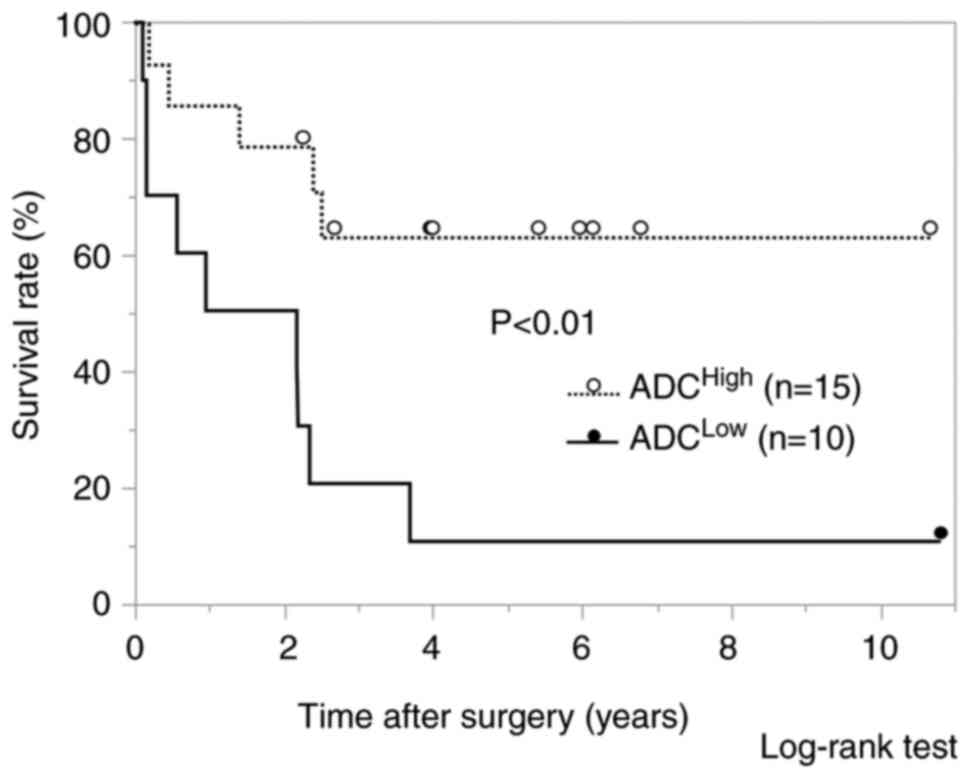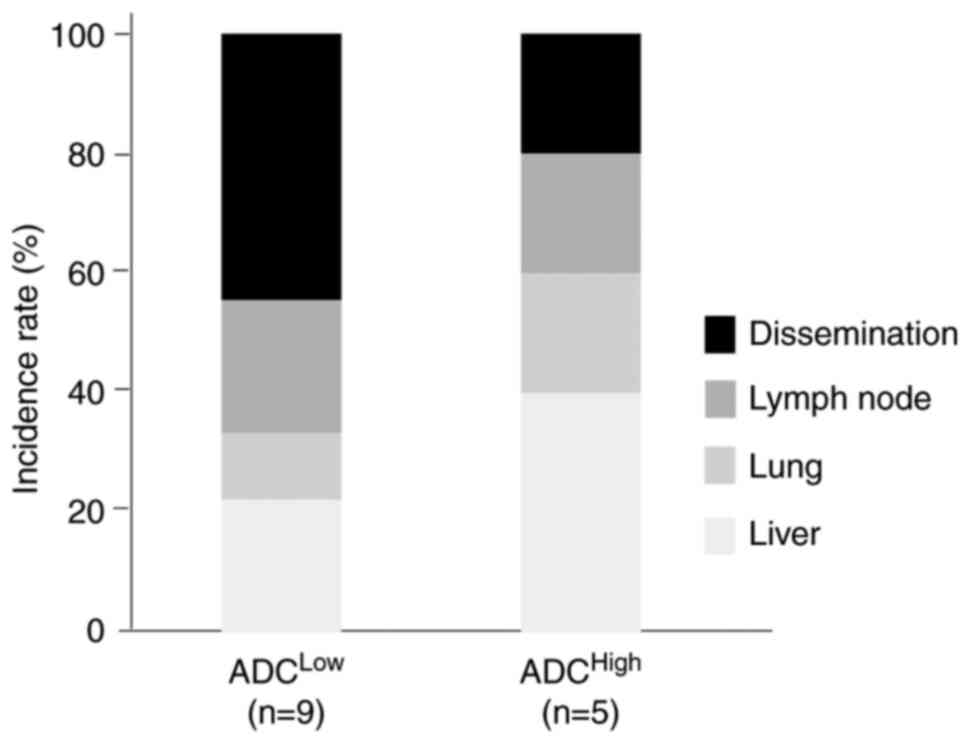Evaluation of malignancy in gallbladder tumors using the apparent diffusion coefficient obtained by diffusion‑weighted MRI
- Authors:
- Published online on: September 4, 2024 https://doi.org/10.3892/ol.2024.14666
- Article Number: 533
Abstract
Introduction
Gallbladder cancer is a frequent malignant tumor of the biliary tract and shows a poor prognosis (1). It is a highly aggressive malignancy that is hard to diagnose and has few therapeutic options, with a 5–10% 5-year overall survival (OS) rate (2,3). In gallbladder cancer, cases diagnosed at the same tumor stage sometimes show different prognoses because of its heterogeneity (4). Additionally, distinguishing benign tumors from malignant tumors is difficult by conventional imaging modalities (5). Therefore, accurate and early imaging diagnoses are necessary for selecting appropriate therapy and improving prognosis.
Although ultrasonography is considered one of the most reliable imaging modalities for evaluating gallbladder disease, it is hard to diagnose early lesions because of its low specificity and sensitivity (6). Morphological evaluation using computed tomography (CT) is also widely used. However, it is hard to distinguish gallbladder cancer from other benign tumors such as chronic cholecystitis (7). In recent years, diffusion-weighted imaging (DWI) of magnetic resonance imaging (MRI) has shown radical improvement in the detection of malignant tumors (8). DWI is a functional MRI technique that can assess diffusion of water molecules and evaluate the pathological condition of organs and tissue at a high scan speed without a contrast agent. A quantitative assessment of diffusion characteristics can be presented by apparent diffusion coefficient (ADC) values (9); they are decreased in areas in which diffusion is restricted, such as in tissue with high cellularity or rich stroma. Previously, it has been reported that ADC values could estimate the characteristics of various malignancies (10,11). Our previous study also demonstrated that ADC values can estimate the prognosis of intrahepatic cholangiocarcinoma (12). Previously, DWI was shown to support the diagnosis of gallbladder malignancy and can also distinguish gallbladder cancers from benign tumors in gallbladder (6), while the ADC value can estimate the histological grade of primary gallbladder carcinoma (13).
The present study examined the utility of ADC values in the evaluation of malignancies and in the prognostic prediction of gallbladder tumors.
Materials and methods
Patients and MRI imaging
In the present study, a total of 63 patients (44 female and 19 male patients; median age, 62 years; age range, 25–91 years) who underwent surgical resection for gallbladder tumors at the Department of Surgery, Tokushima University Hospital, between January 2011 and December 2023 were enrolled. The patients that were included: i) Underwent DWI of MRI within 1 month before surgical resection; ii) showed no previous treatment before surgical resection, and no extrahepatic metastasis; and iii) had a gallbladder tumor confirmed pathologically. Cases of non-curative resection (R2) and patients that underwent neoadjuvant chemotherapy were not included in the present study. Regarding gallbladder cancer, morphological and pathological characteristics and the Japanese Tumor-Node-Metastasis stage were assessed according to the guidelines of the Japanese Society of Biliary Surgery (14).
MR images were obtained with 1.5-T superconducting units (Signa HDe/Explorer; GE Healthcare) using 8-channel phased-array coil. Fast spin-echo T2-weighted images and DWI (b=0, 20, 800 s/mm2) were obtained. Using ADC maps on Synapse Vincent (ver. 6.8; Fujifilm Healthcare), the mean ADC values (×10−3 mm2/sec) of tumors were calculated in regions of interest with manual tracing (12). Synapse Vincent can obtain the maximum, minimum and mean values in free-form green lines automatically (Fig. 1). In the present study, mean ADC values were used as previously reported (15), and cases of gallbladder cancer were divided into non-advanced gallbladder cancer, whereby the tumor depth was the mucosa or muscular layer, and advanced gallbladder cancer, in which the tumor depth was deeper than the muscular layer. In advanced gallbladder cancer (n=25), patients were divided into 2 groups using the ADC value: An ADCHigh group (n=15) and an ADCLow group (n=10). Using receiver operating characteristic analysis, of which the endpoint is cancer death, the cut-off value of 1.2×10−3 mm2/sec was defined (area under the curve: 0.75, sensitivity: 72.7%, specificity: 85.7%, Fig. 2). The present study was approved by the Institutional Review Board of the Tokushima University Hospital (approval no. 3977-2; Tokushima, Japan). The requirement for written consent was waived for the present study by the ethical approval committee.
Statistical analysis
The Fisher's exact test was used to compare the patients' backgrounds of the two groups. For multiple comparisons, the Kruskal-Wallis test and Steel-Dwass post hoc test were used. Disease-free survival (DFS) and OS curves were generated using the Kaplan-Meier method and differences were evaluated by the log-rank test. Cox proportional hazards model was used for multivariate survival analysis. P<0.05 was considered to indicate a statistically significant difference, and all statistical analyses were performed by JMP v.8.0.1 (SAS Institute Inc.).
Results
ADC value of gallbladder tumors
In the present study, there were 33 benign tumor cases, 5 non-advanced gallbladder cancers, and 25 advanced gallbladder cases. Patients' characteristics in benign tumors and gallbladder cancers are presented in Tables I and II. Images of representative cases of tumor are revealed in Fig. 3. ADC values of benign tumors and gallbladder cancer are included in Tables I and II. The mean ADC value was 2.72×10−3 mm2/sec in benign tumors, 1.88×10−3 mm2/sec in non-advanced gallbladder cancer and 1.36×10−3 mm2/sec in advanced gallbladder cancer. ADC values in the three groups are demonstrated in Fig. 4. ADC values in advanced gallbladder cancer were significantly lower compared with benign tumors and non-advanced gallbladder cancer (P<0.05). Furthermore, ADC values in early gallbladder cancer were also significantly lower compared with benign tumors (P<0.05).
Evaluation of malignancy with ADC in advanced gallbladder cancer
The backgrounds of patients with advanced gallbladder cancer are revealed in Table III. The ADCLow group tended to have a higher rate of advanced stage disease (P=0.21), and a significantly higher rate of adjuvant chemotherapy compared with the ADCHigh group (P<0.05). Regarding OS, significantly worse prognosis was shown in the ADCLow group compared with the ADCHigh group (P<0.01) (Fig. 5). The univariate and multivariate analyses of OS are shown in Table IV. Poor differentiation and low ADC value were identified as independent prognostic factors. Regarding DFS, the ADCLow group also showed a significantly worse prognosis than the ADCHigh group (P<0.01) (Fig. 6). The univariate and multivariate analyses of DFS are demonstrated in Table V. Low ADC value was identified as an independent prognostic factor. Furthermore, the ADCLow group revealed a higher rate of extra-hepatic recurrence compared with ADCHigh group (Fig. 7).
Discussion
In the present study, the usefulness of ADC in the estimation of malignancy and in prognostic prediction was demonstrated. First, ADC values in malignant and benign gallbladder tumors were investigated. ADC values in advanced gallbladder cancer were significantly lower than those in benign tumors and non-advanced gallbladder cancer, and ADC values in non-advanced gallbladder cancer were significantly lower than those in benign tumors. Differentiation of early malignant and benign gallbladder tumors using conventional CT and MRI has been reported to be difficult and challenging (16–18). It is hard to diagnose gallbladder carcinoma when it reveals wall thickness because it is more common than the wall thickness of inflamed gallbladder. Furthermore, although polypoid tumors >1 cm in diameter have the potential to be cancer, benign gallbladder tumors >1 cm are frequent (19,20). The present study confirmed that non-advanced gallbladder cancer could be distinguished from benign tumors using ADC values. Therefore, when polypoid lesions show relatively low ADC values and are suspicious for early gallbladder cancer, laparoscopic radical cholecystectomy may be considered (21).
A small number of studies (7,22–29) have used ADC values to differentiate gallbladder carcinoma from benign tumors (Table VI). These studies stated that ADC values are useful for distinguishing gallbladder carcinoma and benign tumors. Lee et al (27) demonstrated sensitivity, specificity, positive predictive value and negative predictive value of 97.2, 92.2, 83.3 and 98.8%, respectively. However, these cut-off points vary between studies, which limits their clinical validity. Kitazume et al (7) revealed that the lesion to spinal cord ratio was more accurate than ADC. Sulieman et al (29) showed that the P-value between gallbladder carcinoma and benign tumor was 0.07, although the P-value of b800/b0 ratio was <0.01. This correction of ADC value with other lesions using the b-value ratio may reduce this validity.
Next, malignancy in advanced gallbladder cancer using ADC values was estimated. A previous study reported that tumor differentiation was inversely related to the ADC value (13). It was previously reported that low ADC value is associated with aggressive tumor types and high HIF-1α expression, which accelerates tumor malignancy in intrahepatic cholangiocarcinoma (12). Furthermore, Min et al (15) showed that the low ADC value in gallbladder cancer was associated with poor differentiation, T stage, lymph node metastasis and progression stage. In the present study, the ADCLow group tended to have a higher rate of advanced stage, which represented tumor aggressiveness. Min et al (15) also confirmed that low ADC values could estimate long-term DFS. The current study revealed a significant difference in OS, not only in DFS, and the ADCLow group showed more extrahepatic distant recurrence compared with the ADCHigh group, indicating an aggressive recurrence pattern.
The present study has some limitations. First, selection bias could exist because only patients with gallbladder tumors who underwent MRI were retrospectively analyzed. Second, patients in the present study underwent treatment at a single center, and the number of patients was small. Statistical size calculations were not conducted, and sample size of the present study gave post hoc powers of 22%. Therefore, further analysis in a larger, prospectively collected population is necessary to confirm these results.
In conclusion, ADC values from DWI-MRI may estimate the malignancy of gallbladder tumors and predict the prognosis of patients with advanced gallbladder cancer.
Acknowledgements
The authors would like to thank Dr H. Nikki March for editing a draft of this manuscript.
Funding
Funding: No funding was received.
Availability of data and materials
The data generated in the present study may be requested from the corresponding author.
Authors' contributions
YM, MS and SY designed the study. CN, SY, HT, YW, YS, TI and TN contributed to collection of the data. SY and CN wrote the main manuscript text, confirmed the authenticity of all the raw data and prepared all figures. All authors read and approved the final manuscript.
Ethics approval and consent to participate
The present study was approved by the Ethics Committee of Tokushima University Hospital (approval no. 3977-2; Tokushima, Japan). An information disclosure statement was presented in the homepage of the institute website for opt-out, and the requirement for informed consent was waived.
Patient consent for publication
An information disclosure statement was shown in the homepage of Tokushima University Hospital website for opt-out; The manuscript and images are published and freely available.
Competing interests
The authors declare that they have no competing interests.
References
|
Hickman L and Contreras C: Gallbladder cancer: Diagnosis, surgical management, and adjuvant therapies. Surg Clin North Am. 99:337–355. 2019. View Article : Google Scholar : PubMed/NCBI | |
|
Cubertafond P, Gainant A and Cucchiaro G: Surgical treatment of 724 carcinomas of the gallbladder. Results of the French Surgical Association Survey. Ann Surg. 219:275–280. 1994. View Article : Google Scholar : PubMed/NCBI | |
|
Lim H, Seo DW, Park DH, Lee SS, Lee SK, Kim MH and Hwang S: Prognostic factors in patients with gallbladder cancer after surgical resection: Analysis of 279 operated patients. J Clin Gastroenterol. 47:443–448. 2013. View Article : Google Scholar : PubMed/NCBI | |
|
Alizadeh AA, Aranda V, Bardelli A, Blanpain C, Bock C, Borowski C, Caldas C, Califano A, Doherty M, Elsner M, et al: Toward understanding and exploiting tumor heterogeneity. Nat Med. 21:846–853. 2015. View Article : Google Scholar : PubMed/NCBI | |
|
Scara S, Bottoni P and Scatena R: CA 19-9: Biochemical and clinical aspects. Adv Exp Med Biol. 867:247–260. 2015. View Article : Google Scholar : PubMed/NCBI | |
|
Ratanaprasatporn L, Uyeda JW, Wortman JR, Richardson I and Sodickson AD: Multimodality imaging, including dual-energy CT, in the evaluation of gallbladder disease. Radiographics. 38:75–89. 2018. View Article : Google Scholar : PubMed/NCBI | |
|
Kitazume Y, Taura S, Nakaminato S, Noguchi O, Masaki Y, Kasahara I, Kishino M and Tateishi U: Diffusion-weighted magnetic resonance imaging to differentiate malignant from benign gallbladder disorders. Eur J Radiol. 85:864–873. 2016. View Article : Google Scholar : PubMed/NCBI | |
|
Parikh T, Drew SJ, Lee VS, Wong S, Hecht EM, Babb JS and Taouli B: Focal liver lesion detection and characterization with diffusion-weighted MR imaging: Comparison with standard breath-hold T2-weighted imaging. Radiology. 246:812–822. 2008. View Article : Google Scholar : PubMed/NCBI | |
|
Jiang T, Xu JH, Zou Y, Chen R, Peng LR, Zhou ZD and Yang M: Diffusion-weighted imaging (DWI) of hepatocellular carcinomas: A retrospective analysis of the correlation between qualitative and quantitative DWI and tumour grade. Clin Radiol. 72:465–472. 2017. View Article : Google Scholar : PubMed/NCBI | |
|
Kurosawa J, Tawada K, Mikata R, Ishihara T, Tsuyuguchi T, Saito M, Shimofusa R, Yoshitomi H, Ohtsuka M, Miyazaki M and Yokosuka O: Prognostic relevance of apparent diffusion coefficient obtained by Diffusion-Weighted MRI in pancreatic cancer. J Magn Reson Imaging. 42:1532–1537. 2015. View Article : Google Scholar : PubMed/NCBI | |
|
Parsian S, Giannakopoulos NV, Rahbar H, Rendi MH, Chai X and Partridge SC: Diffusion-weighted imaging reflects variable cellularity and stromal density present in breast fibroadenomas. Clin Imaging. 40:1047–1054. 2016. View Article : Google Scholar : PubMed/NCBI | |
|
Yamada S..Morine Y, Imura S, Ikemoto T, Arakawa Y, Saito Y, Yoshikawa M, Miyazaki K and Shimada M: Prognostic prediction of apparent diffusion coefficient obtained by diffusion-weighted MRI in mass-forming intrahepatic cholangiocarcinoma. J Hepatobiliary Pancreat Sci. 27:388–395. 2020. View Article : Google Scholar : PubMed/NCBI | |
|
Lee NK, Kim S, Moon JI, Shin N, Kim DU, Seo HI, Kim HS, Han GJ, Kim JY and Lee JW: Diffusion-weighted magnetic resonance imaging of gallbladder adenocarcinoma: Analysis with emphasis on histologic grade. Clin Imaging. 40:345–351. 2016. View Article : Google Scholar : PubMed/NCBI | |
|
Japanese Society of Biliary Surgery, . Classification of biliary tract carcinoma, second English edition. Tokyo: Kanehara & Co., Ltd.; 2004 | |
|
Min JH, Kang TW, Cha DI, Kim SH, Shin KS, Lee JE, Jang KT and Ahn SH: Apparent diffusion coefficient as a potential marker for tumour differentiation, staging and long-term clinical outcomes in gallbladder cancer. Eur Radiol. 29:411–421. 2019. View Article : Google Scholar : PubMed/NCBI | |
|
Yun EJ, Cho SG, Park SW, Kim WH, Kim HJ and Suh CH: Gallbladder carcinoma and chronic cholecystitis: Differentiation with two-phase spiral CT. Abdom Imaging. 29:102–108. 2004. View Article : Google Scholar : PubMed/NCBI | |
|
Yoshimitsu K, Honda H, Kaneko K, Kuroiwa T, Irie H, Ueki T, Chijiwa K, Takenaka K and Masuda K: Dynamic MRI of the gallbladder lesions: Differentiation of benign from malignant. J Magn Reson Imaging. 7:696–701. 1997. View Article : Google Scholar : PubMed/NCBI | |
|
Demachi H, Matsui O, Hoshiba K, Kimura M, Miyata S, Kuroda Y, Konishi K, Tsuji M and Miwa A: Dynamic MRI using a surface coil in chronic cholecystitis and gallbladder carcinoma: Radiologic and histopathologic correlation. J Comput Assist Tomogr. 21:643–651. 1997. View Article : Google Scholar : PubMed/NCBI | |
|
Levy AD, Murakata LA and Rohrmann CA Jr: Gallbladder carcinoma: Radiologicepathologic correlation. RadioGraphics. 21:295–314, questionnaire, 549–555. 2001. View Article : Google Scholar : PubMed/NCBI | |
|
Levy AD, Murakata LA, Abbott RM and Rohrmann CA Jr: From the archives of the AFIP. Benign tumors and tumorlike lesions of the gallbladder and extrahepatic bile ducts: Radiologic-pathologic correlation. Armed Forces Institute of Pathology. Radiographics. 22:387–413. 2002. View Article : Google Scholar : PubMed/NCBI | |
|
Piccolo G and Piozzi GN: Laparoscopic radical cholecystectomy for primary or incidental early gallbladder cancer: The new rules governing the treatment of gallbladder cancer. Gastroenterol Res Pract. 2017:85705022017. View Article : Google Scholar : PubMed/NCBI | |
|
Sugita R, Yamazaki T, Furuta A, Itoh K, Fujita N and Takahashi S: High b-value diffusion-weighted MRI for detecting gallbladder carcinoma: Preliminary study and results. Eur Radiol. 19:17942009. View Article : Google Scholar : PubMed/NCBI | |
|
Irie H, Kamochi N, Nojiri J, Egashira Y, Sasaguri K and Kudo S: High b-value diffusion-weighted MRI in differentiation between benign and malignant polypoid gallbladder lesions. Acta Radiol. 52:236–240. 2011. View Article : Google Scholar : PubMed/NCBI | |
|
Ogawa T, Horaguchi J, Fujita N, Noda Y, Kobayashi G, Ito K, Koshita S, Kanno Y, Masu K and Sugita R: High b-value diffusion-weighted magnetic resonance imaging for gallbladder lesions: Differentiation between benignity and malignancy. J Gastroenterol. 47:1352–1360. 2012. View Article : Google Scholar : PubMed/NCBI | |
|
Solak A, Solak I, Genc¸ B and Sahin N: The role of diffusion-weighted examination in non-polyploid gallbladder malignancies: A preliminary study. Turk J Gastroenterol. 24:148–153. 2013. View Article : Google Scholar : PubMed/NCBI | |
|
Kim SJ, Lee JM, Kim H, Yoon JH, Han JK and Choi BI: Role of diffusion-weighted magnetic resonance imaging in the diagnosis of gallbladder cancer. J Magn Reson Imaging. 38:127–137. 2013. View Article : Google Scholar : PubMed/NCBI | |
|
Lee NK, Kim S, Kim TU, Kim DU, Seo HI and Jeon TY: Diffusion-weighted MRI for differentiation of benign from malignant lesions in the gallbladder. Clin Radiol. 69:e78–e85. 2014. View Article : Google Scholar : PubMed/NCBI | |
|
Kyung N, Kim S, Moon JI, Shin N, Kim DU, Seo HI, Kim HS, Han GJ, Kim JY and Lee JW: Diffusion-weighted magnetic resonance imaging of gallbladder adenocarcinoma: Analysis with emphasis on histologic grade. Clin Imaging. 40:345–351. 2016. View Article : Google Scholar : PubMed/NCBI | |
|
Sulieman I, Mohamed S, Elmoghazy W, Alaboudy A, Khalaf H and Elaffandi A: The value of diffusion-weighted imaging in diagnosing gallbladder malignancy: Performance of a new parameter. Clin Radiol. 76:709.e7–709.e12. 2021. View Article : Google Scholar : PubMed/NCBI |



